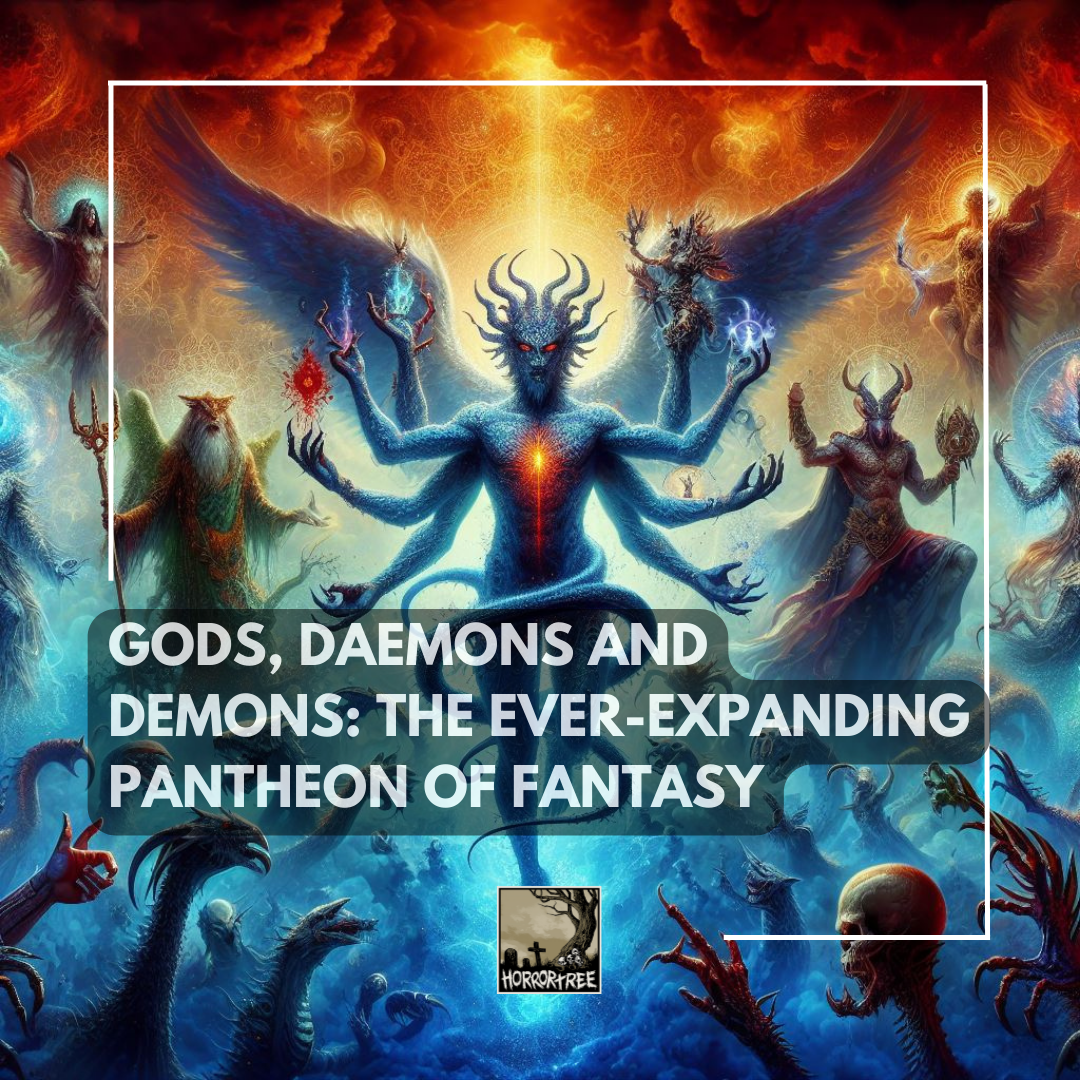Gods, Daemons and Demons: The Ever-Expanding Pantheon of Fantasy

The Hapless Writings of a Canadian Fantasy Author
Gods, Daemons and Demons: The Ever-Expanding Pantheon of Fantasy
In this latest from his regular series, Canadian-born, UK-based fantasy author Matthew Ducharme has something to say about our fantastical, non-human fauna and flora.
There are many recipes to good fantasy, and a multitude of forms it can take, but there are two ingredients that must always be present: magic and mythical creatures.
I argued in my second article that fantasy can’t truly be fantasy without magic. I believe this to be true—if you disagree, let me know why in the comments (though you’re still wrong)—but I also believe fantasy requires fantastical creatures.
Elves, dwarves, orcs, goblins, hobbits, balrogs, and myriad others in the well-known Tolkien-inspired stables are, for me (and most of you too, I bet), the first to come to mind. But in my—our—defence, these creatures have dominated the fantasy of 20th and 21st centuries. They’ve been a sort of foundation for the genre’s collective lore.
Take, for example, TTRPG. I’m an avid tabletop gamer. I’ve played games like Hero Quest, Warhammer and D&D for waaaay longer than it’s been cool—thanks for the bump, Stranger Things—where these creatures are also commonplace staples. In game, we know which monsters, non-human races, and beasts of burden to expect.
Games that use miniatures are, by design, very static; if there isn’t a miniature, it’s not in the game, simple as that. D&D, however, has a lot more freedom, also by design. An experienced DM (Dungeon Master for those of you who haven’t played) can throw in some weird and wonderful new monsters, so long as they follow the rules of the game, but that’s rare. Still, most of what we see comes from the (now vastly expanded upon, and still expanding) Tolkien pantheon.
But there’s so much more out there, and we’re seeing them rear their (often ugly) heads. A sprawling array of cultural creatures are being called upon to create specific mythical environments that deviate from the standard tropes, but still fall under the beautiful umbrella that is fantasy.
From the West, Ancient Greek history feeds most of what we know. But that was, of course, pulled from a wide range of more ancient cultures spanning North Africa, Pakistan, the Mongolian Steppe, through to pre-Roman Celtic Europe. Centaurs, hydras, unicorns, minotaurs, sirens, trolls, sprites: the Greek bestiary, for Westerners, is a familiar one. These creatures are often found in ‘typical’ fantasy, because, well, Tolkien himself drew from this repertoire.
I’m not saying that these creatures are boring, but after decades reading story upon story with these beasts, I’m finding it exciting to see writers bring entirely new creatures to the fray. In the wonderful way we’re expanding published voices, we are living in a beautiful time of exploration for those of us unfamiliar with the depth of global cultures.
Neighbouring the Greek-seeded Western lore, Slavic tradition has also bled liberally into fantasy from every aspect. Baba Yaga, for example, plays a huge role in what we currently think of as a ‘witch’. A broomstick-riding old crone who dwells in the darkest parts of the forest, known for terrorising villages, eating their children—it’s a trope all of us can recognise from countless stories.
And I would be out of order if I didn’t mention vampires. One of the mythos’ most famous creatures, they’re so deeply woven into the fabric of fantasy, they’re basically synonymous with the genre. What else needs to be said? The name registers instantly with everyone. From Stoker’s Dracula to the inconceivably popular sparkly vamp-romance that plagued pop culture for far too long, vampires are integral to fantasy. And while Baba Yaga herself might not be so commonplace as vampires, the form her character lent to witches appears so frequently there’s no point even listing titles. They’re just…everywhere.
Close to my heart and (admittedly subjugated) homeland, Native North American lore features an entirely different stable of creatures. Skin-walkers, the Wendigo, jackalope and Sasquatch to name a few, are derived from a vast and varied wilderness, from a lore birthed in isolation from external influence (until Europe decided to change that).
Native American culture is so intrinsically connected to nature that many of its ‘mythical’ creatures aren’t even truly myth. Rather, we see weather, plants and animals, represented in stylised iterations of the People’s interactions with them over millennia.
Foxes are frequent. Known for their wit, they’re tricksters, constantly taking advantage of gullible humans. So too are wolves, bears, eagles, bobcats, wolverines, owls, and many, many other animals, each with their own unique set of traits. The Peoples of North America encountered and interacted with animals over thousands of years. Lived in a sense of harmony with nature, not subjugating it. This symbiosis with the environment gave rise to real relationship development with nature. North American Native cultures spent time getting to know the creatures they coexisted with so personally, they were able to attribute entire sets of human-like personalities to them.
The story of Elatsoe, a contemporary fantasy journey by Darcie Little Badger, that takes place in an alternate present-day America, forged by magic, monsters and legends of its people. Elatsoe has the power to summon dead animal spirits; knowledge passed down to her through generations of her Lipan Apache family, that she will use to uncover the truth behind her cousin’s mysterious passing. The story also features some wonderfully powerful nature magic, like creating orbs of light and being able to travel through fungal networks that I highly recommend as a breath of fresh air.
And there is so much more. From a deep reservoir of lore, held behind the barrier of stigma for decades has begun to trickle forth in earnest. Documentation of Native American stories were made by English and French settlers over the years of colonisation, but these were taken out of context, not given proper background, and, most importantly, given from the wrong perspective. Now, like the tales of Nanabush, from many Algonquin tribes, the stories are coming forth, down the annals of heredity, directly from the source. Look HERE for the tale of the Indian Summer.
Jumping to the literal opposite side of the globe, Asian lore is as wide and varied as the continent itself, and features huge contrast in its own unique mythical races and fauna.
India, while drawing from Buddhism and Hinduism (or the other way around), draws deeply from its own specific wildlife. Naga, a race of serpent-human hybrids, despite the dangerous nature of their natural counterparts, are often portrayed as benevolent protagonists. Rakshasas, however, are evil human-eating demons, known to antagonise people at every opportunity. Opposite them, the kind nature spirits Yakshas are connected to fertility and the wilderness. Even the pantheon of Hindu gods can be partially considered to fall into the fantastical creatures, with obvious characters like Ganesh, the elephant-headed god, known for bringing luck and removing obstacles for pious humans being foremost among them.
The Shiva Trilogy, by Amish Tripathi, dives into the ancient realm of Hinduism—with a spin. Here, gods were once humans, and earned their godhood through extraordinary acts. In this story, we follow Shiva in his human form as he helps the Meluhans to defend their kingdom from the evil Nagas.
Over the Himalayas and into China we find rabbits, crows, dogs, and cats all over the lore, but the bestiary is dominated by dragons. Oh, sure we find them elsewhere, but Chinese dragons are a class of their own entirely. Vastly different from Western dragons, Chinese dragons differ widely even amongst themselves. Separated into four sub-categories—scaled (Jiaolong), winged (Yinglong), horned (Quilong), and hornless (Chilong)—they represent an array of different Yang aspects of luck and power. Slightly less prevalent, yet equally important, the opposing force of Yin is represented by the white tiger, depicting patience, resilience, and the formless strength of water.
The Poppy War, by R. F. Kuang, is a brilliant example of Chinese fantasy. A complete divergence from the standard, Western model, it dives into he pantheon of gods and mythology surrounding them from the perspective of Fang Runin (Rin), the last surviving member of a people utterly destroyed in a seemingly never-ending series of wars, who can call down the power of her god, the Phoenix, and unleash fire upon the world, bending it to her will. It’s a brutal story, filled with horror, sadness and the ugly honesty of human nature, but one I can’t recommend enough.
And, of course, I don’t think it’s possible to discuss Chinese fantasy without mentioning the Monkey King. Journey to the West, written in the 16th century by Wu Cheng’en, is an ancient epic considered China’s preeminent classic novel. Sun Wukong, a monkey born of a stone, fed by the Five Elements, masters combat and the secrets to immortality. The 100-chapter epic follows Sun Wukong through his uprising, 500-year imprisonment, and subsequent redemption as a Buddha after serving as one of Tang Sanzang’s disciples. Ok, I know! This is an extremely boiled down version that does not do it justice. Go out, find a copy and read it.
While certainly seeded by Chinese mythology, Japanese mythological creatures have some commonalities, but quickly branch off to become a lore entirely its own. While the Hoo is essentially a one-to-one stand in for the fenghuang (phoenix), and dragons very much follow the Chinese tradition, there are so many more that deviate entirely.
Oni—big club-toting, horned brute—are cast as villains in many stories. The clever, shape-shifting fox-like tricksters Kitsune appear similarly to their North American kin, but here, also appear as friends, guardians, and even a romantic interest for human protagonists.
Much of today’s Japanese fantasy comes in the form of Manga and/or Anime, but you see all of these tropes throughout. Inuyasha literally translates to Dog Yaksha, a demon himself, who faces countless other demons. Unsurprisingly, he encounters Oni, Kitsune, and so many more creatures straight out of Japanese lore.
Everywhere you look, mythological creatures rear their animal heads all over human lore. We (humans, I mean), are not original creatures. Rather, we take from our surroundings, adapt, adjust, and develop, until we create something that feels new. There are—not surprisingly—similarities across cultures, because we perceive our environments through similar lenses. Cultural specifics add tint to this perception, but it is all human.
And this is why I’m so excited about the explosion of different cultural viewpoints in fantasy. It’s all fantasy and—to me anyway—it’s all bloody fantastic..
Find my previous articles HERE.
- About the Author
- Latest Posts
Matthew Ducharme is a Canadian-born fantasy author living in Surrey, England. He also has superpowers – that is, he’s neurodiverse. Equal parts super-help and super-hinderance, his ADHD-riddled mind makes every day an adventure. Convinced he was stupid as a child, over time he learned to navigate his own chaotic mind. Now channelling his energy successfully,
Matthew enjoys little more than exploring the seemingly limitless expanse of his creativity.
His epic fantasy series (currently querying) was started during the pandemic to give his overactive mind an outlet on the long, quiet stretches. He also dabbles in other forms and genres, but fantasy is his true love. To pursue that further, he’s on the committee of the British Fantasy Society.
Competing for true love honours: his work in the cruise ship industry, which takes him around the globe; his tabletop gaming; the outdoors (archery, mountain biking, fishing, and more); and his wife and two cats (the little furballs hate when he focuses on writing, instead of them).
Check out his landing page here.













